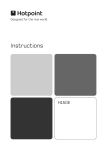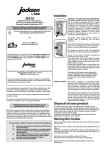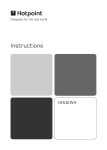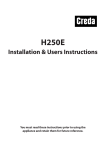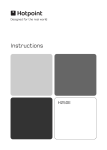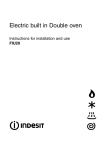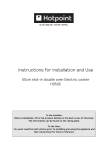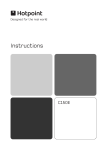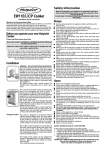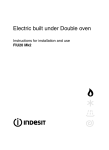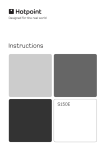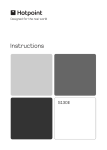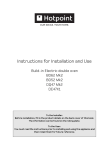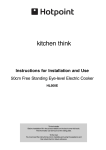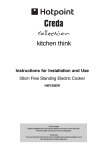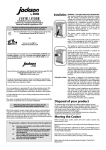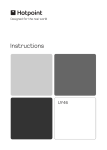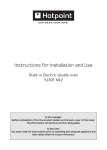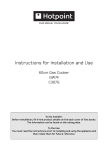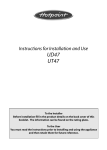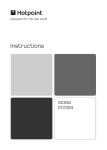Download Hotpoint H251EWH User's Manual
Transcript
Instructions H251EWH Contents Introduction 2 Installation 3 For Your Safety - Always 4 For Your Safety - Never 5 Features 6 Control Panel 7 Hotplate General Information Notes 8-9 Temperature Conversion chart 10 Grill 11 Guide to Grilling 12 Oven Timer Operation 13 Know Your Timer 14 Clock & Automatic Timer Operation 15-18 Top Oven Cookery Notes 19-21 Main Oven Cookery Notes 22-25 Care & Cleaning 26-27 Cooking Results not Satisfactory 28 Something Wrong? 29 Service Back Cover You must read these instructions prior to using the appliance and retain them for future reference. 1 Introduction Your new appliance is guaranteed* and will give lasting service. This guarantee is only applicable if the appliance has been installed in accordance with the installation instructions detailed in this booklet. To help make best use of your cooking equipment, please read this booklet carefully. The cooker is designed specifically for domestic use and responsibility will not be accepted for use in any other installation. When the cooker is first used an odour may be emitted, this will cease after a period of use When first using the cooker ensure that the room is well ventilated (e.g. open a window or use an extractor fan) and that persons who may be sensitive to the odour avoid any fumes. It is suggested that any pets be removed from the room until the smell has ceased. This odour is due to temporary finish on oven liners and elements and also any moisture absorbed by the insulation. * The guarantee is subject to the provisions that the appliance: (a) (b) (c) (d) Has been used solely in accordance with the Users Instruction Book. Has been properly connected to a suitable supply voltage as stated on the rating plate attached to this equipment. Has not been subjected to misuse or accident or been modified or repaired by any person other than the authorised employee or agent. Has been correctly installed. DISPOSAL OF YOUR PRODUCT To minimise the risk of injury to children please dispose of your product carefully and safely. Remove all doors and lids. Remove the mains cable (where fitted) by cutting off flush with the appliance and always ensure that no plug is left in a condition where it could be connected to the electricity supply. To help the environment, Local Authority instructions should be followed for the disposal of your product. This appliance conforms to the following EEC Directives: Electromagnetic Compatibility Low Voltage Equipment 89/336/EEC 73/23/EEC 92/31/EEC 93/68/EEC 93/68/EEC 2 Installation WARNING – THIS APPLIANCE MUST BE EARTHED. MAINS CONNECTION Your cooker should have been checked to ensure that the voltage corresponds with your supply voltage, this is stated on the rating plate, which is situated on the rear panel. The cooker must be connected by a competent person such as a NICEIC registered contractor to a suitable double-pole control unit with a minimum rating of 32A (30A double-pole control switch installations found in older properties are acceptable) and a minimum contact clearance of 3mm, which should be fitted adjacent to the cooker, in accordance with IEE regulations. The control unit must be within 2 metres of but not directly above the appliance and should be easily accessible in the event of an emergency. The power supply cable should conform to B.S.6004 with a conductor size of 6mm2, minimum. Access to the mains terminals is gained by removing the rear access cover. The mains cable must pass through the cable clamp adjacent to the terminal block. Sufficient cable should be used to allow the cooker to be pulled out for servicing. Ensure that the mains cable is routed away from any brackets affixed to the rear panel and is not trapped to the rear wall when pushing the cooker into position between cabinets. COOKER HEIGHT Your cooker must stand on a flat surface so that the hob is perfectly level, and the cooker is stable and cannot be rocked. Note: If the cooker is to be placed on a base, precautions must be taken to prevent it from slipping off the base. SITING THE COOKER The cooker is designed to fit between kitchen cabinets spaced 500mm apart. The space either side need only be sufficient to allow withdrawal of the cooker for servicing. It can be used with cabinets one side or both as well as in an angled corner setting. It can also be used freestanding. Adjacent side walls which project above hob level, must not be nearer to the cooker than 150mm and should be protected by heat resistant material. Any overhanging surface or cooker hood should not be nearer than 650mm. The height of the cooker can be adjusted by means of adjustable feet in the plinth (900 915mm). Adjust the feet by tilting the cooker from the side. Then install the cooker into position. MOVING THE COOKER Before moving your cooker, switch off at the cooker control unit, ensure that it is cool. Open the grill door sufficiently to allow a comfortable grip on the underside front edge of the oven roof, avoiding any grill elements. Note: Take care in moving the cooker as it is heavy. Take care to ensure that any floor covering is not damaged. RADIO INTERFERENCE This appliance conforms to EN 55014 regarding suppression of radio and television interference. 3 Safety Information When used properly your appliance is completely safe but as with any electrical product there are certain precautions that must be observed. PLEASE READ THE PRECAUTIONS BELOW BEFORE USING YOUR APPLIANCE. Always ● Remove all packing from the appliance before switching on for the first time. ● Understand the controls prior to using the appliance. ● Keep children away from the appliance when cooking as the surfaces will get extremely hot during and after use. ● Turn controls off when not in use. ● Stand back when opening an oven door to allow any build up of steam or heat to disperse. ● Always use dry good quality oven gloves when removing items from the oven/grill. ● Always place pans centrally over the hotplate making sure handles are kept away from the edge of the hob and cannot become heated by other hotplates or pans. ● Always take care to avoid heat or steam burns when operating the controls. ● Always turn off the electricity supply at the wall switch and allow the appliance to cool before cleaning (or changing an oven lamp if fitted). ● Always make sure the shelves are in the correct position before switching on the oven or grill. ● Always keep the oven/grill door closed when the appliance is not in use. ● Always keep the appliance clean as a build up of grease or fat from cooking can cause a fire. ● Always follow the basic principles of food handling and hygiene to prevent the possibility of bacterial growth. ● Always keep ventilation slots clear of obstructions. ● Always refer servicing to a qualified appliance service engineer. ● Always take care when removing items from the grill compartment when the lower oven is in use as the contents will be hot ● Always turn off the electricity supply to the appliance at the wall switch should any glass panel (if fitted) crack or shatter and then DO NOT USE THE APPLIANCE until repaired. ● During use, the oven becomes hot. Care should be taken to avoid touching heating elements inside the oven. 4 Safety Information Never ● Never stare at Halogen heating units ● Never leave children unsupervised where a cooking appliance is installed as all surfaces will be hot during and after its use. ● Never allow anyone to sit or stand on any part of the appliance. ● Never store items above the appliance that children may attempt to reach. ● Never leave anything on the hob surface when unattended and not in use. ● Never remove the oven shelves whilst the oven is hot. ● Never heat up unopened food containers as pressure can build up causing the container to burst. ● Never store chemicals/food stuffs or pressurised containers in or on the appliance, or in cabinets immediately above or next to the appliance. ● Never place flammable or plastic items on or near the hob. ● Never fill a deep fat frying pan more than 1/3 full of oil, or use a lid. DO NOT LEAVE DEEP FAT FRYING PANS UNATTENDED WHILE COOKING. ● Never use the appliance as a room heater. ● Never use the grill to warm plates. ● Never dry any items on either the hob or oven doors. ● Never install the appliance next to curtains or other soft furnishings. ● Never operate the grill with the grill door closed as this will cause the appliance to over heat. ● Never use steam cleaners. SAFETY ADVICE IN CASE OF A CHIP-PAN FIRE In the event of a chip pan fire or any other pan fire. 1. TURN OFF THE COOKER APPLIANCE AT THE WALL SWITCH. 2. COVER THE PAN WITH A FIRE BLANKET OR DAMP CLOTH, this will smother the flames and extinguish the fire. 3. LEAVE THE PAN TO COOL FOR AT LEAST 60 MINUTES BEFORE MOVING IT. Injuries are often caused by picking up a hot pan and rushing outside with it. NEVER USE A FIRE EXTINGUISHER TO PUT OUT A PAN FIRE as the force of the extinguisher is likely to tip the pan over. Never use water to extinguish oil or fat fires. 5 Features RATING PLATE (ON REAR PANEL) CONTROL PANEL RIGHT REAR HOTPLATE 1500W RIGHT FRONT HOTPLATE 1500W RED SPOT LEFT REAR HOTPLATE 1000W LEFT FRONT HOTPLATE 2000W RED SPOT GRILL TOP OVEN STAY CLEAN SIDE PANEL GRILL PAN TOP OVEN/GRILL ROD SHELF MAIN OVEN STAY CLEAN SIDE PANEL MAIN OVEN ROD SHELF MODEL/SERIAL NO. 6 Control Panel TIMER REAR LEFT HOTPLATE CONTROL FRONT LEFT HOTPLATE CONTROL FRONT RIGHT HOTPLATE CONTROL REAR RIGHT HOTPLATE CONTROL TOP OVEN CONTROL GRILL CONTROL MAIN OVEN CONTROL CONTROL KNOBS The knobs for the grill and hotplates can be rotated in either direction to provide variable heat control, the oven knobs can only be rotated clockwise from the Off position. Note Always ensure that all controls are in the OFF position, when appliance is not in use. 7 Hotplates General Information Notes Note: Under no circumstances should the hob be used with aluminium foil in contact with the hob surface. Use of Hotplates The controls set the hotplates at six pre-set power levels. Each control can be used to select one of six temperature settings from a minimum at position 1 to a maximum at position 6. The red spot hotplates heat up more rapidly to give faster boiling. Control Settings Guide This table is provided only as a guide – settings also depend on the type of pan used and the quality of food. Knob Position 1 1 or 2 3 Type of food To melt butter, chocolate etc. To heat food gently. To keep small amounts of water simmering. To heat sauces containing egg yolks and butter. To simmer: stews, meat, fish, vegetables, fruit. To heat solid or liquid foods. Keep water boiling. Thaw frozen vegetables. Make 2-3 egg omelettes. 4 or 5 To cook foods, just above simmering. To maintain ‘rolling’ boil for preserve making. 5 or 6 To seal meat and fry fish. 6 Frying potatoes. Bringing water to the boil. Deep fat frying. Dissolve sugar for preserve making. Safety requirements for deep fat frying 1. 2. 3. 4. 5. 6. 7. 8 Use a deep pan, large enough to completely cover the appropriate heating area. Never fill the pan more than one-third full of oil. Never leave oil or fat unattended during the heating or cooking period. Never try to fry too much food at a time, especially frozen food. This only lowers the temperature of the oil or fat too much, resulting in greasy food. Always dry food thoroughly before frying, and lower it slowly into the hot oil or fat. Frozen foods, in particular, will cause frothing and spitting, if added to quickly. Never heat fat, or fry, with a lid on the pan. Keep the outside of the pan clean and free from streaks of oil or fat. Hob General Information CHOICE OF UTENSILS Every Electric Hob deserves the right choice of utensils. We recommend for optimum performance the use of good quality utensils. PANS SHOULD NOT Be concave (bowed in) Always ✓ Never ✗ ● Use good quality flat-based cookware on all electric heat sources. ● Use gauze, metal pan diffusers, asbestos mats and stands e.g. Wok stands – they can cause overheating. ● Ensure pans have clean, dry bases before use. ● Ensure pans match size of heating area. Be convex (bowed out) Be rimmed ● Use badly dented or distorted pans. ● Remember good quality pans retain heat well, so generally only a low or medium ● Leave an element switched on when not cooking. heat is necessary. ● Ensure pan handles are positioned safely and away from heat sources. ● Lift pans, do not drag. Be deeply ridged ● Use utensils with skirts or rims e.g. buckets and some kettles. ● Use pan lids except when frying. ● Cook food directly on the hotplate. ● Drag or slide utensils across the hob surface. ● Place large preserving pans or fish kettles across two hotplates. ● Deal with spillage immediately ● Place plastic vessels or but with care. utensils on a hot hob. But essentially Flat ● Use the hob as an area for storage Always place pans centrally on the hotplate 9 Temperature Conversion Chart 10 Gas Mark ˚F Main Convection Oven Top Convection Oven Main Fan Oven 1/2 250 120 110 100 1 275 140 130 120 2 300 150 140 130 3 325 160 150 140 4 350 180 170 160 5 375 190 180 170 6 400 200 190 180 7 425 220 210 200 8 450 – 220 210 9 475 – – 220 Grill Setting the Grill Door in grilling position Grill pan handle CAUTION – ACCESSIBLE PARTS WILL BECOME HOT WHEN THE GRILL IS IN USE. CHILDREN SHOULD BE KEPT AWAY. GRILLING SHOULD NOT BE UNDERTAKEN WITH THE GRILL DOOR CLOSED. Never line the grill pan with aluminium foil. The grill control is designed to provide variable heat control of the grill element. Please note that the grill will not operate unless the top oven control is in the OFF position. Open the top oven/grill door, preheat the grill at High setting for approximately 5 minutes. When toasting the rod shelf is placed in the top runner. Position the pan centrally below the grill element. Leave the control at High for toast, sealing and fast cooking of foods. For thicker cuts requiring longer cooking, turn the control to a lower setting after the initial sealing on both sides at High. The thicker the food the lower the control should be set. See chart on guide to grilling. Remember to switch off the grill control at the end of cooking. The grill pan handle is detachable from the pan, to facilitate cleaning and storage. The handle can be either detachable from or fixed to the pan. For a fixed handle remove the screw and washers from the grill pan bracket, tilt the handle over the recess adjacent to the bracket. Slide the handle towards the centre of the pan and let the handle locate over the bracket. Replace screw and washers and ensure that they are fully tightened up. For a detachable handle remove screw and washers from grill pan and discard. Warning: Ensure when using grill pan handle in the detachable manner it is centralised and secure. 11 Guide To Grilling Pre-heat the grill for 5 minutes on maximum control setting before grilling. GRILL CHART Setting Shelf Position from base of oven Toasting of Bread Products High 2 3-10 mins depending on type of food Small cuts of meat, sausages, bacon Med 2 15-20 mins Chops, etc. Gammon steaks Med 1 20-30 mins Fish: whole fillets fingers Med Med Med 1 2 2 cook on base of pan 10-30 mins 10-30 mins Pre-cooked potato products Med 2 10-20 mins Pizzas Med 1 Preheat pan first 8-15 mins Browning of food High 1 5-10 mins Food Approx.Cooking Time The settings in the above guide have been developed to cook food successfully without excessive fat spitting and splashing. 12 Oven Timer Operation The oven timer offers you the following features: 1. 2. Time of Day Automatic Cooking AUTOMATIC COOKING The Top Oven and Main Oven can be controlled by the automatic timer. When the timer control has been set for one oven it is possible to use the other oven only on the same automatic cooking programme. NEVER OPERATE THE GRILL WHEN THE OVENS ARE SET TO COOK AUTOMATICALLY. HINTS ON AUTOMATIC COOKING 1. Select foods which will take the same time to cook and require approximately the same temperature. 2. Set the oven timer so that the food has just finished or about to finish cooking on your return to the oven. This will ensure the food has not cooled down and does not require reheating before serving. 3. Food should be as cold as possible when it goes into the oven, ideally straight from the refrigerator. Frozen meat and poultry should be thawed thoroughly before it is put in the oven. 4. We advise that warm food should never be placed in the oven if there is to be a delay period. Stews prepared by frying the meat and vegetables should be cooked as soon as possible. 5. We advise dishes containing left-over cooked poultry or meat, for example Shepherds Pie, should not be cooked automatically if there is to be a delay period. 6. Stews and joints should be cooked by the long slow method, so that the delay period is kept to a minimum. 7. On warm days, to prevent harmful bacterial growth in certain foods (ie poultry, joints, etc) the delayed start should be kept to a minimum. 8. Wine or beer may ferment and cream may curdle during the delay period, so it is best to add these ingredients just before serving. 9. Foods which discolour should be protected by coating in fat or tossing in water to which lemon juice has been added, prior to placing food in the oven. 10. Dishes containing liquid should not be filled too full to prevent boiling over. 11. Food should be well sealed (but not airtight) in a container to prevent the loss of liquid during cooking. Aluminium foil gives a good seal. 12. Ensure food is cooked thoroughly before serving. TIMER OPERATION 1. Make sure all oven controls are turned Off. 2. Check that the electricity supply to the oven is turned On. 3. Check that the oven clock is at the right time of day. 13 Know Your Timer COOK PERIOD START TIME TIMER FUNCTIONS Time of Day Main Clockface Ensure correct time of day is always set. AUTO COOKING PROGRAMME Start Time The time of day at which you want an “Auto Cooking” programme to start. Cook Period (Up to 180 minutes) The Cook period in minutes will be shown in the display window. Cook Period is the actual length of time for which, the timer will switch the oven(s) on as part of an “Auto Cooking” programme. (e.g. If you set 180 minutes, the food will be cooked for 180 minutes). For Example: If you set a "Start Time" of 1l.00am", and a "Cook Period" for 180 minutes. The timer will switch the oven(s) on at 1l.00am and turn the oven(s) off at 2.00pm. You will hear an audible tone at 2.00pm to indicate that the Auto Cooking programme has finished. Notes: When setting an Auto Cooking programme you will need to set the oven control(s) to the required temperature(s) when you set the timer, and if necessary select the appropriate oven function. If an Auto Cooking programme has been set the oven(s) will only operate during the pre-programmed time. 14 Clock & Automatic Oven Timer Operation TO SET & RE-SET THE TIME OF DAY Step 1 Make sure all oven controls are turned Off. Step 2 Check the electricity supply to the cooker is switched on. Step 3 Push and turn knob (B) anti-clockwise until the correct time of day is shown. Note: For normal "Manual" operation of the oven(s) the timer should always be set at , the position in the display window (as shown). See Below. TO SET THE TIMER FOR MANUAL OVEN OPERATION Note: Unless you set the timer for an Auto Cooking Programme, for normal "Manual" operation of the oven(s) the timer should always be set to the position. If the symbol does not appear in the display window :- Step 1 Turn knob (B) anti-clockwise until the the display window. symbol does appear in 15 Clock & Automatic Oven Timer Operation AUTO COOKING PROGRAMMES There are two Auto Cooking programmes that can be selected using your timer:– (a) To set the Timer to switch the oven(s) ON immediately and OFF at a preset time - Up to 180 minutes. (b) To set the Timer to switch the oven(s) ON and OFF Automatically. a) TO SET THE TIMER TO SWITCH THE OVEN(S) ON IMMEDIATELY AND OFF AT A PRE-SET TIME – UP TO 180 MINUTES. Step 1 Check that the correct time of day is set, if not follow instructions for setting the time of day. Step 2 Place food onto the correct shelf position in the oven and close the oven door. Step 3 Turn knob (B) anti-clockwise until the required cook period in minutes is indicated in the display window. e.g. 90 minutes (as shown). Note: Cook period is the length of time that you wish the food to cook (Up to 180 minutes). Step 4 Turn the oven control(s) to the required temperature, and if necessary select the appropriate oven function. At the end of the Cook Period, the oven(s) will switch off and a Bell will ring. Step 5 Return the oven control to the OFF position. Step 6 To cancel the Bell and return the timer to "Manual Operation", turn knob (B) anti-clockwise, until the symbol is shown in the display window. Note: Cancel Bell The bell can be cancelled by turning knob (B) anti-clockwise until the symbol is shown in the display window. For normal oven operation, turn knob (B) anti-clockwise until the symbol is shown in the display window. 16 Clock & Automatic Oven Timer Operation b) TO SET THE TIMER TO SWITCH THE OVEN(S) ON AND OFF AUTOMATICALLY Step 1 Check that the correct time of day is set, if not follow instructions for setting the time of day. Step 2 Place food onto the correct shelf position in the oven and close the oven door(s). Step 3 Set the “Start Time” by pushing and turning knob (A) anti-clockwise, until the required start time is set. This allows the auto function to be set. Note: The "Start Time" is the time of day you want the Auto Cooking programme to start. Step 4 Set the "Cook Period" by turning knob (B) anti-clockwise, until the required cook period in minutes is indicated in the display window. e.g. 90 minutes (as shown). Note: The "Cook Period" is the length of time that you wish the food to cook, and it can be set for up to 180 minutes. Step 5 Turn the oven control(s) to the required temperature, and if necessary select the appropriate oven function. Note: If an “Auto Cooking Programme” has been set the oven(s) will ONLY operate during the pre-programmed times. At the end of the Auto Cook Period the oven(s) will switch off and a bell will ring. Step 6 Return the oven controls to the OFF position. Step 7 To cancel the Bell and return the timer to "Manual Operation", turn knob (B) anti-clockwise, until the symbol is shown in the display window. Note: Cancel Bell The bell can be cancelled by turning knob (B) anti-clockwise until the symbol is shown in the display window. For normal oven operation, turn knob (B) anti-clockwise until the symbol is shown in the display window. 17 Clock & Automatic Oven Timer Operation TO CANCEL AN AUTO COOKING PROGRAMME Step 1 Turn the oven control(s) to their OFF position. Step 2 Turn knob (B) anti-clockwise until the the display window. 18 symbol appears in Top Oven - Cookery Notes TOP OVEN COOKING The Top Oven is used in exactly the same way as the main oven to cook all types of food. It can either be used alone, to cook small quantities of food, or in conjunction with the main oven to provide additional cooking space, so often necessary when entertaining. There are two cooking positions, the shelf placed directly on the floor of the oven, or one runner from the floor of the oven. To correctly position the rod shelf the side rods with indents must be uppermost and to the rear, this forms a stop position in conjunction with the side liners. The correct positioning of food is indicated in the top oven charts. These charts are a guide only, giving approximate cooking temperatures and times. To suit personal tastes and requirements, it may be necessary to increase or decrease temperatures by 10°C. Food must never be placed directly on the floor of the oven without a shelf in position, and there should always be at least 25mm (1”) between the top of the food and the grill element. Always ensure a 75mm (3”) gap is left at the front of the baking tray to ensure even cooking. COOKING MEAT/POULTRY IN THE TOP OVEN The top oven is most useful for the longer, slower cooking methods required for cheaper cuts of meat, casserole cooking, pot roasting and braising. Small joints of meat up to 1.5kg (3 lbs) or poultry up to 2.5kg (6 lbs) in weight can be roasted in a small meat pan in the top oven, but should preferably be slow roasted or covered with a lid of aluminium foil (one or two incisions in the top of the foil will allow the meat or poultry to brown). Always ensure that there is at least 25mm (1”) between the top of the foil and the grill element. Larger joints of meat weighing more than 1.5kg (3 lbs), or poultry weighing more than 2.5kg (6 lbs), should be roasted in the main oven. TOP OVEN AS A HOT CUPBOARD Plates and dishes placed on the floor of the top oven will be heated when the main oven is in use. When the main oven is not in use (for instance when a meal is being cooked on the hob) place the plates and serving dishes on the rod shelf, using the bottom runner, and turn the top oven control to approximately 100°C. A maximum time of 10 - 12 minutes is all that is required to heat the plates and dishes. Do not operate the grill control when using the top oven for cooking or as a hot cupboard. 19 Top Oven Temperature Chart - Baking Food Preheat Temperature and Time Position in oven Scones Yes 200˚C 9-12 mins Runner 1 from bottom of oven Small Cakes Yes 180˚C approx. 15-20 mins Runner 1 from bottom of oven Victoria Sandwich Yes 170˚C 61/2" tins approx. 20 mins Sponge Sandwich (Fatless) Yes 180/190˚C approx.15 mins Runner 1 from bottom of oven Swiss Roll Yes 190/200˚C 9-12 mins Runner 1 from bottom of oven Semi-rich Cakes Yes 160/180˚C 61/2 - 7" tins 11/4 - 11/2 hrs Shelf placed directly on floor of oven Rich Fruit Cakes Yes 150˚C approx. 7 - 8" tins 2 - 21/4 hrs Shelf placed directly on floor of oven Shortcrust Pastry (plate Tarts Yes 190/200˚C 40-45 mins Shelf placed directly on floor of oven Puff Pastry Yes 200/220˚C approx. Time depending on use. Yorkshire Pudding Yes 200˚C approx. 40-45 mins Runner 1 from bottom of oven Individual Yorkshire Puddings Yes 200˚C approx. 40-45 mins Runner 1 from bottom of oven Milk Puddings Yes 140˚C 2 - 21/2 hrs Baked Custard Yes 150˚C approx. 40-45 mins Bread Yes 210˚C for 10 mins 200/210˚C for approx. further 30 mins Meringue Yes 100/110˚C Shelf placed directly on floor of oven Runner 1 from bottom of oven or shelf placed directly on floor of oven Shelf placed directly on floor of oven Large 31/2 - 4 hrs Small 21/2 - 3 hrs Runner 1 from bottom of oven Shelf placed directly on floor of oven Runner 1 from bottom of oven Note: Always refer to cookery notes before using the oven. If soft tub margarine is used for cakes, temperatures recommended by the manufacturer should be followed. Temperatures recommended in this chart refer to cakes made with block margarine or butter only. 20 Top Oven Temperature Chart - Meat Food Beef / Lamb (slow roasting) Beef / Lamb (foil covered) Pork (slow roasting) Pork (foil covered) Veal (slow roasting) Veal (foil covered) Poultry / Game (slow roasting) Poultry / Game (foil covered) Casseroles cooking Preheat Yes Yes Yes Yes Yes Yes Yes Yes Yes Temperature and Time Position in oven 170/180˚C approx. 35 mins per 450g (1lb) + 35 mins over 190/200˚C approx. 35-40 mins per 450g 170/180˚C approx. 40 mins per 450g (1lb) + 40 mins over 190/200˚C approx. 40 mins per 450g (1lb) 170/180˚C approx. 40-45 mins per 450g (1lb) + 40 mins over 190/200˚C approx. 40-45 mins per 450g (1lb) 170/180˚C approx. 25-30 mins per 450g (1lb) + 25 mins over 190/200˚C approx. 25-30 mins per 450g (1lb) + 25 mins over Shelf placed directly on floor of oven Approx. 150˚C 2 - 21/2 hrs If using aluminium foil: 1. Remember it is important to increase the cooking time by one third. 2. Never allow foil to touch sides of oven. 3. Never cover oven interior with foil. 4. Never cover oven shelves with foil. 21 Oven Oven Control With the oven door closed, heating of the oven is achieved by turning the control clockwise to the required ‘oven temperature’ scale on the control panel, as recommended in the temperature charts. The pilot light will immediately come on and go off during cooking as the thermostat maintains the correct temperature. Note: At the end of the cooking period there may be a momentary puff of steam when the oven door is opened. This will disperse in a few seconds and is perfectly normal characteristics of an oven with a good door seal. Note: Remember to switch off the oven control after cooking is finished. Oven Cookery Notes To prepare meat for roasting in your electric oven 22 The ‘oven temperature charts’ are a guide only, giving approximate cooking temperatures and times. To suit personal taste and requirements, it may be necessary to increase or decrease temperatures by 10˚C. Wipe the joint, dry well with a clean cloth, kitchen tissue, etc., and weigh it. Meat which has been stored in a refrigerator, should be allowed to come to room temperature for approximately 30 minutes before cooking. Always completely thaw frozen meat before cooking. Beef, lamb and mutton may be lightly floured, but pork should have the rind scored, brushed over lightly with olive oil, and sprinkled with salt – for crisp crackling. Place the joint in a suitably sized meat pan (a small joint in a large meat pan causes unnecessary oven splashing). Small joints weighing less than 1.5kg (3lbs) may be pot roasted. Additional fat should not be used, except for veal, very lean meat, poultry, which can either be ‘larded’ with fat bacon, or brushed over very sparingly with melted fat/cooking oil. When potatoes are roasted round the joint, they only require to be coated in melted fat/cooking oil. It is not necessary to baste, when roasting in an electric oven, and liquid/stock should not be added to a meat pan. Oven Cookery Notes Temperature and Time The secret of succulent, tender meat, is not to roast quickly at too high a temperature. Best results are obtained when roasting is carried out at low temperatures. When a lower temperature is used, the joint loses less weight, is more tender (too high a temperature causes meat to be tough and dry), and the splashing of fat onto oven interior is reduced. When a complete meal is being cooked in the oven, cooking time may need to be increased, and temperature may need to be raised for approximately the last 30 minutes of the cooking period (for instance when cooking Yorkshire pudding to serve with roast beef). The times and temperature suggested should be used as a guide but may vary according to:– 1. Whether you prefer meat rare, medium or well done. 2. The size and shape of your joint. a) A short thick joint requires a longer cooking period than a long thin joint. b) A small joint under 1.5kg (3lbs) takes longer per 450g (1lb) than a large one, whereas a large joint over 3kg (6lbs) will cook in the time given for ‘minutes’ per 450g (1lb) without the ‘minutes’ over added. c) Boned/rolled and stuffed joints take longer to cook through than those with a bone. (The weight of stuffing should be added to the oven ready weight of meat/poultry to calculate roasting times.) Meat pan and rod shelves Never use meat pans larger than 390 x 300mm (15”x12”) and baking trays no larger than 330x255mm (13”x10”), these should be positioned centrally on the oven shelf. Food should not be placed directly on the floor of the oven. To avoid unnecessary cleaning, rod shelves which are not in use, should be removed from the oven. 23 Main Oven Temperature Chart - Baking Temperature and Time Position in oven from bottom Food Preheat Scones Yes 220/230˚C approx. 10-15 mins Runners 1 and 4 Small Cakes Yes 190/200˚C approx. 20-25 mins Runners 1 and 4 Victoria Sandwich Yes 180/190˚C 61/2 - 7" tins approx. 20mins 8 - 81/2" tins approx. 30mins Runners 1 and 4 Sponge Sandwich (Fatless) Yes 190/200˚C 7"tins 15-20 mins Runners 1 and 4 Swiss Roll Yes 200/210˚C approx. 10-15 mins Runner 4 Semi-rich Cakes (large) Yes 160/170˚C 61/2 - 7" tins 11/4 - 11/2 hrs 8 - 9" tins 2 - 21/2 hrs Runner 3 Christmas Cake Yes 140/150˚C - Shortcrust Pastry Yes 200/210˚C depending on use. Runners 2 and 5 Puff Pastry Yes 220˚C approx. depending on use. Runners 2 and 5 Yorkshire Pudding Yes 210/220˚C 45-50 mins Runner 5 Individual Yorkshire Puddings Yes 210/220˚C approx. 20-35 mins Runner 5 Milk Puddings Yes 150/160˚C approx. 2 - 21/2 hrs Runner 2 Baked Egg Custard Yes 150/160˚C approx. 45-55 mins Runner 2 Bread (full oven) Bread (single loaf) Yes 230˚C 50-60 mins 230˚C 45-50 mins reducing to 210/220˚C after first 10 mins Meringue Yes 100/110˚C Large 31/2 - 4 1/2 hrs Small 21/2 - 3 hrs dependant on size and richness of mixture. Runner 3 Runners 1 and 4 Runner 1 Note: Always refer to cookery notes before using the oven. If soft tub margarine is used for cakes, temperatures recommended by the manufacturer should be followed. Temperatures recommended in this chart refer to cakes made with block margarine or butter only. 24 Main Oven Temperature Chart - Meat Food Preheat Beef Yes Lamb Yes Pork Yes Veal Yes Poultry / Game Yes Turkey Yes Temperature and Time Position in oven 190/200˚C approx. 25-30 mins per 450g (1lb) + 25 mins extra 190/200˚C approx. 25-30 mins per 450g (1lb) + 25 mins extra 190/200˚C approx. 30-35 mins per 450g (1lb) + 30 mins extra In a meat tin on Runner 2 190/200˚C approx. 25-35 mins per 450g (1lb) + 30 mins extra 180/190˚C approx. 18-20 mins per 450g (1lb) + 20 mins extra up to 5.5kg (12lb) allow 22 mins per 450g (1lb) at190˚C eg. 5kg (11lb) = 242 mins In a suitable tin on Runner 1 over 5.5kg (12lb) allow 16 mins per 450g (1lb) at 180˚C eg. 10kg (22lb) = 352 mins Casseroles cooking Yes 140/160˚C approx. according to quantity Runner 3 If using aluminium foil: 1. Remember it is important to increase the cooking time by one third. 2. Never allow foil to touch sides of oven. 3. Never cover oven interior with foil. 4. Never cover oven shelves with foil. 25 Care and Cleaning WARNING Turn off the main switch before cleaning. Before switching on again, ensure that all controls are in the off position. Never use biological washing powder, harsh abrasives, scouring pads, aerosols cleaners or oven chemical cleaners of any kind. CONTROL PANEL Wipe with a damp cloth wrung out in warm soapy water and polish with a dry cloth. Stubborn stains can be removed with a cream, paste or liquid cleaner. Care must be taken to ensure that this does not come into contact with plastic parts. HOB Clean hob with a cloth wrung out in warm soapy water. Stubborn stains can be removed with a cream, paste or liquid cleaner, or by gently rubbing with liberally soaped, very fine steel wool pads. Check that the cleaning agent used is approved by the Vitreous Enamel Development Council. OVEN DOORS Wipe over the door outer panels with a cloth wrung out in warm soapy water, then after wiping with a cloth wrung out in clear water, dry with a soft clean cloth. Do not use scouring pads or abrasive powder which may scratch the surface. Clean the door inner panels with a cloth wrung out in soapy water. Stubborn stains can be removed with a cream, paste or liquid cleaner, or by gently rubbing with liberally soaped, very fine steel wool pads. Check that the cleaning agent used is approved by the Vitreous Enamel Development Council. 26 Care and Cleaning HOW ‘STAY CLEAN’ WORKS The surface of the ‘Stay clean’ oven liners are treated on the mottled face with a special vitreous enamel which absorbs cooking soils. At temperatures of 220˚C (425˚F) or above, the special surface enables these soils to be slowly destroyed. The higher the temperature the more effective it is. In most cases normal cooking operation at this temperature will permit this cleaning operation to proceed during cooking. However if higher cooking temperatures are not used regularly it may be necessary, to prevent heavy soiling, to run the oven without rod shelves or a meat pan at maximum setting for a couple of hours. This may be necessary once a month or once every two or three months, depending on the type and amount of oven cooking. ‘STAY CLEAN’ OVEN LINERS It should not normally be necessary to clean the oven liners. If the user feels it is desirable to do so remove the rod shelves and wash the side panels in warm soapy water followed by rinsing in clear water. GRILL/TOP OVEN Remove the rod shelf, grill pan and the wire grid food support. It is best to wash these items immediately after use to prevent stains from being burnt on when used again. Wipe out the grill/oven compartment, use a fine steel wool soap pad to remove any stubborn stains left on the floor of the compartment. MAIN OVEN Remove the rod shelves and wipe out the oven compartment, use a fine steel wool soap pad to remove any stubborn stains left on the floor of the compartment. CLEANING MATERIALS TO AVOID 1. Plastic or nylon pads 2. Household abrasive powders and scourers, these may scratch the surface. 3. Oven chemical cleaners, aerosols and oven pads. 4. Caustic cleaners, these will etch the surface and attack the metal frame. 5. Bath and sink cleaners may mark the surface. NOTE: We do not recommend the use of decorative covers over the hot hotplates as these can hold condensation and cause corrosion. Accidental operation with a cover in place can cause intense heat. Never place saucepan lids on the hotplates, as this may cause corrosion. 27 Cooking Results Not Satisfactory GRILL Uneven cooking front to back Ensure that the grill pan is positioned centrally below the grill element. Fat splattering Ensure that the grill pan is not lined with foil. Ensure that the grill setting control is not set too high. BAKING GENERAL Uneven rising of cakes Ensure that the oven shelves are level. Sinking of cakes The following may cause cakes to sink: 1. Cooking at too high a temperature. 2. Using normal creaming method with a soft margarine. If using soft margarine, use an all in one method instead of the traditional creaming of the margarine and sugar. Remember when using a food mixer or processor not to over cream soft margarine. Over/undercooking Refer to the cooking times and temperatures given in the Oven Temperature Charts provided, however, it may be necessary to increase or decrease temperatures by 10˚C to suit personal taste. Do not use utensils greater than 56mm (2l⁄4'') in height for roasting. TOP OVEN BAKING Uneven cooking front to back Ensure that the cooking utensil is at least 100mm (4") from the front of the shelf. Uneven rising Ensure that the shelf is level (as above) and that the food is positioned correctly in the oven. Overcooking Remember to reduce cooking temperatures by 10˚C from standard recipes when using the top oven. Food is taking too long to cook Ensure that the cooking utensil used in the top oven is not larger than 300mm x 225mm (12"x 9"). Only cook one item at a time to avoid overloading the oven. 28 Something Wrong ? Before calling a Service Engineer, please check through the following lists. THERE MAY BE NOTHING WRONG. Problem Check Nothing works. If you find :No change in time of day for 5 minutes. Then it is likely that there is no electricity supply to your oven. Check: (i) That the main cooker wall switch is turned on. (ii) Check other appliances to see if you have a power cut. (iii) Check the main circuit breaker for the property. Clock is working but has lost time. The power supply to your oven has possibly been interrupted, but has now come back on again. Reset the timer to the correct time of day and "Manual" operation using instructions given in the timer section of the book. Main & Top Ovens do not work, but the Grill works. Check the following to ensure that the timer is in Manual Mode: Check that the symbol is shown in the display window. See timer section for instructions on how to return timer to "Manual". Top Ovens and Grill do not work, but the Main Oven works. Operating the cooker under the following conditions may cause a safety device to operate. (a) Grilling with the door closed - always grill with the door open to the correct position - see grilling. (b) Grilling for an excessively long period at maximum setting see grilling guide. Grill does not work. Check that you have selected :- Grill setting on the "Grill" knob - see grilling page Ensure that the Top Oven temperature control is fully OFF. Grill keeps turning on and off. When the "Grill" control is operating at less than "H", the grill will cycle on and off, this is normal and is not a fault. Can not set an “Auto Cook” programme Remember: "Cook Period" is the actual length of time for which, the timer will switch the oven(s) on as part of an "Auto Cooking" programme. If you have been through the above list and there is still a problem; Contact Service, see Key Contacts (back cover). 29 Key Contacts After Sales Service Over 1100 trained specialists, directly employed by us, ensure that you can have complete confidence in both the appliances and services we offer. Repair Service and Information Help Desk UK: 08709 066 066 Monday to Friday, 8am to 7.30pm Saturday, 8.30am to 5.30pm Sunday, 9.30am to 3.30pm www.hotpointservice.co.uk Republic of Ireland: 1850 302 200 Note: Our operators will require the following information: Model number Serial number Extended Warranties UK: 08709 088 088 Monday to Sunday, 8am to 8pm www.hotpointservice.co.uk Republic of Ireland: 1850 502 200 Genuine Parts and Accessories UK: 08709 077 077 Monday to Friday, 8.30am to 5pm Saturday, 8.30am to 12noon www.hotpointservice.co.uk Republic of Ireland: (01) 842 6836 www.hotpoint.co.uk Indesit Company UK Limited, Morley Way, Peterborough, PE2 9JB PRINTED BY SIMLEX . FOUR ASHES, WOLVERHAMPTON. 01/2005 Part No. 195047378.01
































